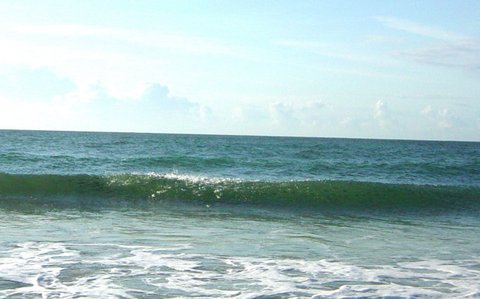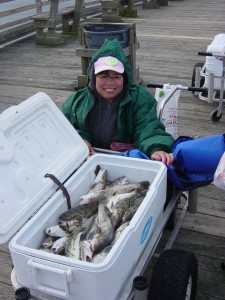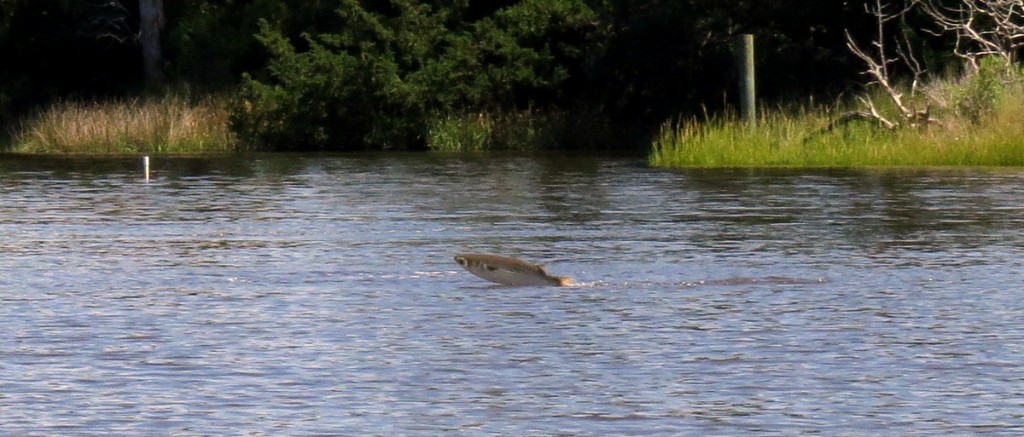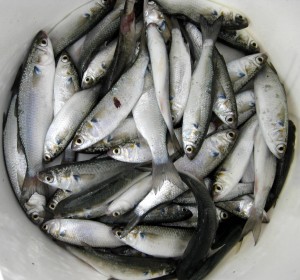“Mullet Blow”! On the Crystal Coast, NOW it’s fall. By Dr.Bogus Fall Mullet Blow
Fall Mullet Blow
NEWS UPDATE: Read my lips, “MULLET BLOW” and right on time for the first MB of the season. What is a mullet blow you ask? Cool breezes, a blast of northeast wind and the finger mullet and the hardhead mullet decide it’s time to head south for their winter spawn…it is the start of the fall fishing season here along the Crystal Coast. “Mullet blow” is the cry. Over the years this biological migratory phenomenon has taken place from late August to early September. Not fall you say, well don’t tell the fish that. The massive migration of these forage fish out of our creeks and sounds, rings the dinner bell for fall to begin, and the drum, flounder and speckled trout are following their tails out the inlets and along our beaches. Dates over the last few years for the FIRST mullet blow (there will be others to follow): 9/1/1999, 9/6/2000, 8/25/2001, 9/1/2002, 9/6/2003, 8/24/2004, 8/26/2005, 9/2/06, 8/29/07, 9/1/08, 9/01/09), 8/28/10, 9/2/11, 8/25/12 8/25/13 and 8/26/14, 8/25/15, 8/30/16 with an average surf temp for those dates of 81° and an average date August 30.
So who are these fish of forage you ask? First of all, they are NOT in anyway related (except via fins) to the sea mullet, a.k.a. kingfish, whiting, also called the Virginia mullet. Those sea mullets are Sciaenids and actually in the drum family.
 Sea Mullet (a.k.a. Kingfish, Virginia Mullet)
Sea Mullet (a.k.a. Kingfish, Virginia Mullet)
The foragable mullets are actually in the Mugilidae family, which contain nearly 70 species of fish worldwide. North Carolina is home for two of these species, which make up some of our most favorite and widely used natural baits. The striped mullet, also known as hardhead, Popeye, or jumping mullet, are the celebrated stars at the annual Swansboro Mullet Festival. The other and more diminutive member of the family is the silver or white mullet, most commonly known on the beach, as the finger mullet, are finger food for many foraging fish.
Named for horizontal stripes that run laterally along their body, the striped Striped (Jumping) Mullet can be found along the west Atlantic coast from Cape Cod to Brazil and often grow to three pounds or more, with a maximum of three feet and weighing in at an astonishing 12-pounds. The silver, or finger mullet are similarly caught up in this yearly spawning pilgrimage to the sea.
By the way, the finger mullet are NOT juvenile striped mullet; they are silver and have no stripes, do not have a flat head or pop-eyes and only attain a diminutive stature of inches and not feet. Since both these fish feed on bits and pieces of living and/or dead vegetation (detritus) neither of these mullets are routinely caught on hook and line, although there are many stories to the contrary, particularly with the striped mullet. Striped mullet have been known to suck up dough balls with a concealed hook inside and I’ve actually landed one on a fly. And yes the mullet was hooked in the mouth! This being the case, nets are the primary mode of mullet fishing.
Commercially, the striped mullet have been harvested via a “stop net” fishery from the ocean beaches or by seine netters. Stop nets are defined by the NC Division of Marine Fisheries as “a stationary net (not intended to gill fish) whose purpose is to impede the progress of schooling fish so that they can be harvested with a seine.” We have all seen the stop nets like a lazy “L” running out from and along the beaches each October and November, and the dories to set the seines and the 1940s vintage tractors to haul in the fish laden seines. The rest of us use cast nets, assuming you’ve mastered throwing one.
Earlier in the season, finger mullet and striped mullet are readily found in the sound, along the piers and docks, along the marshes, particularly on a falling tide and up in the local canals and creeks. For use as bait, the mullet can be readily cast netted from the docks, and banks of the sound or on a boat, drifting along the marshes or in the creeks. Although large striped mullet are often used live for king mackerel baits, most often they are cut into chunks for cut-bait fishing for drum, or Hatteras blues or big strip-baits for trophy flounder. These days, since all of the citation drum fishing is catch and release and much of the puppy drum fishing is similarly a release fishery, many anglers have switched to circle hook fishing while targeting drum with natural baits to minimize gut hooking, and promoting safe release of our state fish.
Small striped mullet (3 to 5-inches) and finger mullet can also be used as cut-bait or more often they are used live for flounder, puppy drum, speckled and gray trout, big Spanish mackerel and blues, and even ladyfish. Rigging is straightforward, I like to lip hook the mullet, from the bottom under it’s chin and through the top of it’s lips, using a Carolina rig either with a circle hook or No. 2/0 Kahle hook. Remember, if you are flounder fishing, give the founder sufficient time to capture, kill and eat your mullet, or there will be lost fish and regrets.
The mullet themselves also can provide good eats, some pickle or can the finger mullet like herring or sardines, and of course the striped mullet is famed for it’s succulent roe while the whole fish is often butterflied and grilled or smoked.


